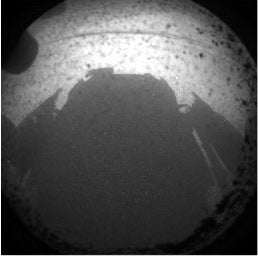The Mars Science Laboratory (MSL) spacecraft that carried Curiosity succeeded in every step of the most complex landing ever attempted on Mars, including the final severing of the bridle cords and flyaway maneuver of the rocket backpack.
“Today, the wheels of Curiosity have begun to blaze the trail for human footprints on Mars,” said NASA Administrator Charles Bolden. “Curiosity, the most sophisticated rover ever built, is now on the surface of the Red Planet, where it will seek to answer age-old questions about whether life ever existed on Mars — or if the planet can sustain life in the future. This is an amazing achievement, made possible by a team of scientists and engineers from around the world and led by the extraordinary men and women of NASA and our Jet Propulsion Laboratory. President Obama has laid out a bold vision for sending humans to Mars in the mid-2030s, and today’s landing marks a significant step toward achieving this goal.”
Curiosity landed at 5h32m UT August 6 near the foot of a mountain 3 miles (5 kilometers) tall and 96 miles (154km) in diameter inside Gale Crater. During a nearly two-year prime mission, the rover will investigate whether the region ever offered conditions favorable for microbial life.
“The ‘Seven Minutes of Terror’ has turned into the Seven Minutes of Triumph,” said NASA Associate Administrator for Science John Grunsfeld. “My immense joy in the success of this mission is matched only by overwhelming pride I feel for the women and men of the mission’s team.”
Curiosity returned its first view of Mars, a wide-angle scene of rocky ground near the front of the rover. Two hours later, it transmitted a higher-resolution image of its new martian home, Gale Crater, taken by one of the vehicle’s lower-fidelity, black-and-white Hazard Avoidance Cameras. More images are anticipated in the next several days as the mission blends observations of the landing site with activities to configure the rover for work and check the performance of its instruments and mechanisms.
“Our Curiosity is talking to us from the surface of Mars,” said MSL Project Manager Peter Theisinger of NASA’s Jet Propulsion Laboratory in Pasadena, California. “The landing takes us past the most hazardous moments for this project and begins a new and exciting mission to pursue its scientific objectives.”
Confirmation of Curiosity’s successful landing came in communications relayed by NASA’s Mars Odyssey orbiter and received by the Canberra, Australia, antenna station of NASA’s Deep Space Network.
Curiosity carries 10 science instruments with a total mass 15 times as large as the science payloads on the Mars rovers Spirit and Opportunity. Some of the tools are the first of their kind on Mars, such as a laser-firing instrument for checking elemental composition of rocks from a distance. The rover will use a drill and scoop at the end of its robotic arm to gather soil and powdered samples of rock interiors, then sieve and parcel out these samples into analytical laboratory instruments inside the rover.
To handle this science toolkit, Curiosity is twice as long and five times as heavy as Spirit or Opportunity. The Gale Crater landing site places the rover within driving distance of layers of the crater’s interior mountain. Observations from orbit have identified clay and sulfate minerals in the lower layers, indicating a wet history.











